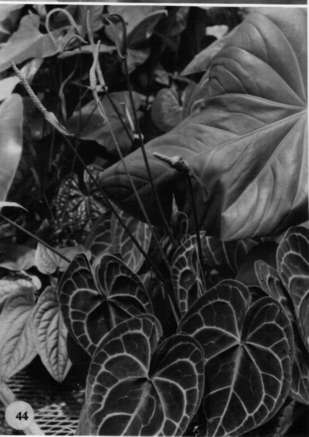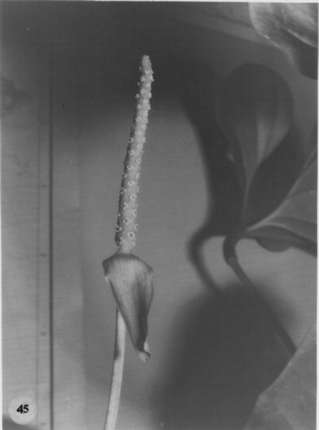




Anthurium clarinervium Matuda,
Anales Inst. Biol. Univ. Nac. Mexico 25:203. 1954. TYPE: Mexico. Chiapas: NE of Ocozocoautia (collected by Ing. Ramirez August 5, 1951) Matuda 25894 (MEXU, holotype).
Terrestrial, deeply rooted among rocks, less frequently epipetric in thin soil on rocks; stems 1-2 cm diam.; leaf scars 1.7 cm wide; cataphylls subcoriaceous, 3-4 cm long, obtuse at apex with subapical apiculum, pale red-violet with pale green speckles, drying brown (B & K Yellow 5/2.5), splitting and persisting.
LEAVES erect to spreading; petioles 7-16 cm long, 4-6 mm diam.,
terete, green or pale red-violel with green speckles; geniculum 1-1.5 cm
long; blades ovate, moderately coriaceous, abruptly to gradually acuminate
at apex, deeply lobed at base, 11-25.5 cm long, 6.5-17 cm wide, broadest
at middle or just below, the margin flat, drying conspicuously undulate;
anterior lobe 6.5-18 cm long, the margins convex; posterior lobes 2.5-9
cm long; sinus spathulate to obovate, the lobes sometimes overlapping,
acute at apex; upper surface matte, velvety, dark green, lower surface
paler, matte; midrib convexly raised, diminishing at apex above, raised
below; primary lateral veins 3-5 per side, raised above, flat below; interprimary
veins conspicuous; basal veins 4-5 pairs, free to base or sometimes the
third to fourth veins coalesced, the first curving to apex, the second
to fourth arcuate-ascending to margin, loop-connecting;
collective vein arising from first basal vein; all veins clearly outlined
by white or greenish white area.
INFLORESCENCE erect-spreading, longer than leaves; peduncles 16-38 cm long, 2-4 mm diam., terete, green tinged with rcd-violet, longer than petioles; spathe chartaceous, pale green tinged with violet-purple near margins (B & K Yellow-green 6/7.5), lanceolate, 3.7-6.5 cm long, 1-1.5 cm wide, broadest at base, narrowly acuminate at apex, obtuse at base, inserted at 40°-70° angle on peduncle; stipe to 5 mm long in front, to 2 mm long in back; spadix green, tinged with violet-purple sometimes appearing brown (B & K Yellow-green 5/5 to Yellow 4/10), 4.7-7.5 cm long, 4-7 mm diam. at base, 3-3.5 mm diam. at apex; flowers sub-4-lobed to square, 3.8-5 mm long, 3.2-5 mm wide, the sides jaggedly sigmoid; 3-4 flowers visible in the principal spiral, 5-8 flowers visible in the alternate spiral; tepals matte, papillate, densely and conspicuously punctate, large droplets visible as stamens emerge, lateral tepals 2.8-3.1 mm wide, the inner margin weakly concave; the pistils weakly emergent usually as soon as spathe opens, green; stigma elliptic, 0.6-1 mm long, brushlike, exserted with large droplets 2-3 days before stamens emerge; stamens emerging rapidly from base on flattened, translucent filaments 1 mm long, 1.5 mm wide, lateral stamens emergent to midway before alternates appear, retracting and held just above tepals; anthers yellow, 0.4-0.8 mm long, 0.7-1.5 mm wide, thecae elliptic, not divaricate, pollen cream fading to white.
INFRUCTESCENCE with bright orange, subglobose berries, ca. 1.5 mm long; mesocarp mealy, seeds not seen. Figs. 44 and 45.
Anthurium clarinervium is probably endemic to Mexico, known only
from areas with limestone outcrops between the Río Grijalva and Río de
la Venta, north of Ocozocoautia dc Espinosa, Chiapas, at 800 to 1,200 m
elevation. Mr. Larry Bussle, a Tampa based horticulturist, claims to have
seen Anthurium clarinervium along the Interamerican highway in Guatemala,
near the Mexican border, but no collections were made to substantiate this
report. The species is a member of section Cardiolonchium
and is recognized by its broadly ovate, velvety leaf blades with all principal
veins much paler than the surface and with a very narrow or closed sinus.
The blades have basal veins usually free to the base or coalesced into
a short posterior rib that is never marginal.
The species has been confused with A. leuconeurum,
which also purportedly originates from southern Mexico but whose exact
origin is unknown. The latter species is distinguished by having a generally
larger, more narrowly ovate blade with an obovate or hippocrepiform sinus
and a conspicuously well developed, naked, posterior rib (i.e., it is marginal
to the sinus). Anthurium clarinervium often occurs in mixed stands
with A. pedaioradiatum, a species that flourishes in the same limestone
outcrop habitats in southern Mexico. The two species readily hybridize
to form a somewhat intermediate plant, having the velvety texture of A.
clarinervium but displaying a somewhat shallowly lobed margin representative
of A. pedatoradiatum (see Croat 40647). In Chiapas the species
is known as "Hoja de corazon." It is now widespread in cultivation, at
least in the United Stales.
 |
 |
Mexico Chiapas: Mpo. San Fernando, 710 m,, 18 May 1988, Breedlove
& Bourell 68260 (CAS).
Mexico Chiapas:, , Breedlove 20274 (DS). Mexico Chiapas: 1000 m,, 15
Aug 1972, Kennedy et al. 1483 (MO).